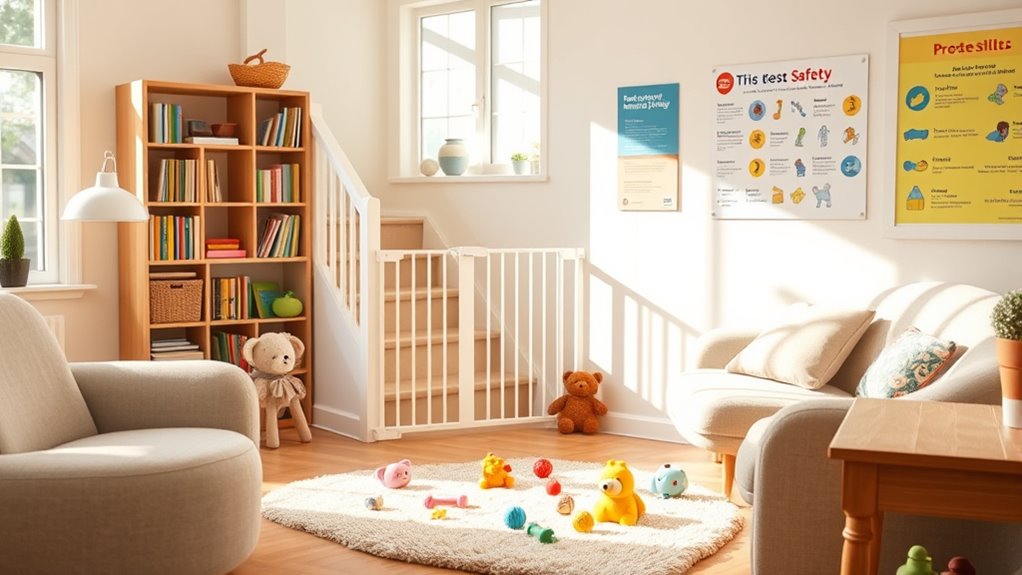To keep your toddler safe, childproofing your home is essential. Start by identifying common hazards, like sharp objects and electrical outlets. Use age-appropriate safety measures, such as cabinet locks and safety gates. Regularly check your environment as your child grows, tackling new risks. Implement effective strategies, like active supervision and creating designated play areas. There are many resources available to support you on this journey, ensuring you keep your little one safe as they explore their world.
Key Takeaways
- Install safety gates at stairways and restrict access to hazardous areas to prevent falls.
- Secure heavy furniture to walls with anti-tip brackets to avoid tip-over accidents.
- Use outlet covers and tamper-resistant outlets to eliminate electrical hazards for curious toddlers.
- Lock away sharp objects and hazardous materials in cabinets with childproof locks to ensure safety.
- Regularly check toys for loose parts and choking hazards to maintain a safe play environment.
Understanding the Importance of Childproofing

As your child begins to explore their world, understanding the importance of childproofing becomes essential for ensuring their safety at home. Each year, over 4.5 million children sustain injuries in their homes, making unintentional injuries the leading cause of death in kids.
With common hazards like choking, drowning, and falls lurking in everyday environments, securing your home is vital. Childproofing allows your little one to discover and learn without constant supervision, fostering both physical and cognitive development. Additionally, implementing evidence-based research on child safety can enhance your childproofing efforts and protect your little explorer from potential dangers. Moreover, ensuring that plant safety is a part of your childproofing strategy can prevent exposure to toxic houseplants. Furthermore, utilizing educational toys can provide safe and engaging play opportunities that promote learning while keeping your child safe. Regularly assessing your home for potential hazards can help identify new risks as your child grows.
Plus, it gives you peace of mind, knowing your home is safe. Remember, childproofing isn’t a one-time task; it evolves as your child grows. Investing in safety measures now saves time and money later, preventing costly accidents and fostering a secure environment for everyone. Additionally, establishing a budget plan for safety improvements can help ensure you allocate resources effectively to childproof your home.
Identifying Common Safety Hazards

While exploring your home, it’s essential to recognize and identify common safety hazards that can pose risks to your toddler.
Start with electrical hazards—ensure outlets are covered and cords are managed to prevent shocks and strangulation. Regularly checking for allergens and pollutants can also contribute to a healthier environment. Consider installing GFCI outlets to further protect against electrical shocks. Additionally, be aware that filial responsibility laws may affect your family’s financial planning as your child grows. Always keep in mind that having survival gear can also be useful in case of emergencies.
Ensure outlets are covered and cords are managed to protect your toddler from electrical shocks and strangulation risks.
In the kitchen, secure appliances and store sharp objects out of reach to avoid burns and injuries.
Unstable furniture is another concern; anchor heavy items to prevent tip-overs. Keeping your living space clean and organized helps minimize potential accidents.
Check for hazards outdoors as well, like pool safety and well-maintained toys.
Finally, keep harmful substances, such as cleaning supplies and medications, locked away.
By identifying these risks, you can create a safer environment for your little one to explore. Additionally, staying informed about financial considerations for elderly care can help you plan for future needs as your family grows.
Stay vigilant, and regularly reassess your home for new hazards as your toddler grows.
Age-Appropriate Safety Measures

Understanding age-appropriate safety measures is essential for keeping your toddler safe as they grow and explore.
For infants, always use a rear-facing car seat and secure furniture to walls to prevent tip-overs. Keep small objects out of reach to avoid choking hazards. Properly assessing developmental milestones can aid in identifying when your infant is ready to explore more. Creating a safe environment for infants is crucial for their overall well-being, as it helps mitigate the risk of accidents related to individual responses to new experiences. Additionally, providing educational toys can promote safe exploration while supporting their cognitive development.
Once your child becomes a toddler, install safety gates on stairs and use outlet covers. Lock away medicines and sharp objects to guarantee safety.
As your toddler approaches preschool age, supervise them near water and teach them about gun safety. Always secure windows and use safety knobs on doors.
In mixed-age families, create safe zones and make sure older children understand their role in keeping younger siblings safe.
Tailor your safety measures to your child’s developmental stage. Furthermore, being aware of the link between cognitive decline can help inform safety measures for older children who may be at risk of accidents due to attention issues.
Essential Tools and Devices for Childproofing

Creating a safe environment for your toddler involves more than just awareness of their developmental stage; it requires the right tools and devices for effective childproofing.
Start with cabinet locks to keep hazardous materials like chemicals and medications out of reach. Use drawer latches to secure sharp objects and tools. Additionally, consider updating your bathroom fixtures to reduce the risk of accidents related to water exposure. Installing a home security system can also provide peace of mind by alerting you to potential intruders, adding an essential layer of protection.
For electrical safety, install outlet covers and consider tamper-resistant outlets. Make sure to secure electrical cords and keep devices unplugged when not in use. Additionally, investing in a home security system can provide an extra layer of safety by alerting you to potential intruders, enhancing your overall home security. Consider implementing eco-friendly toilets in your renovation plans, as they can also contribute to a safer and more efficient home environment.
Don’t forget about furniture safety—use straps and anti-tip brackets to prevent heavy items from toppling over.
Finally, implement safety gates and door knob covers to restrict access to hazardous areas. These essential tools help create a safer home for your little explorer. Additionally, ensuring that your home is free from emotional needs can help create a more peaceful environment for both toddlers and pets.
Effective Parental Strategies for Safety

To guarantee your toddler’s safety, it’s essential to adopt effective parental strategies that promote a secure environment.
Actively supervise your child to guarantee quick intervention when necessary. Secure heavy furniture to walls to prevent tip-over accidents, and keep breakables, cleaning supplies, and sharp objects out of reach. Additionally, ensure that any products used for newborn sunscreens are stored safely out of reach, as these can pose hazards if ingested.
Install gates at the top and bottom of stairs for added safety. Regularly check toys for loose parts to minimize choking hazards.
Establish safe routines by teaching basic safety rules and encouraging healthy eating practices. Create designated play areas free from hazards and promote exploration while guaranteeing supervision. Additionally, consider incorporating digital literacy programs to improve communication strategies as your child grows and begins to navigate technology safely.
Resources for Ongoing Support and Guidance

As you implement effective safety strategies for your toddler, it’s important to know that ongoing support and guidance are readily available.
Resources like the Children’s Safety Network offer insights on topics such as bullying prevention and child passenger safety. Websites like LGI Homes provide childproofing guides, while Headstart offers developmental safety information tailored to your toddler’s age.
You can also access toolkits from the O.U.R. Children’s Safety Project for practical safety skills. For community support, organizations like Hands & Voices and local safety workshops can enhance your knowledge.
Don’t forget online forums and baby-proofing checklists to help you identify potential hazards. Staying informed and connected will make a significant difference in keeping your little one safe.
Frequently Asked Questions
How Often Should I Reassess My Childproofing Measures?
You should reassess your childproofing measures regularly, ideally every few months.
As your child grows and reaches new developmental milestones, their abilities change, exposing them to different risks.
After any accidents or near-misses, it’s vital to evaluate your safety measures immediately.
Seasonal changes might also require adjustments to maintain a safe environment.
Staying proactive guarantees you’re always one step ahead in protecting your child from potential hazards in your home.
What Are the Best Safety Devices for Stairs?
Did you know that over 1,500 children under five suffer stair-related injuries each year?
To protect your little one, consider installing hardware-mounted gates for maximum safety. They’re securely attached to the wall, preventing falls effectively.
Retractable gates are also great for flexible spaces, while mesh gates blend aesthetics with safety.
Verify the gates you choose are JPMA certified and free from tripping hazards to keep your home safe and stylish.
Are There Eco-Friendly Childproofing Options Available?
Absolutely, there are plenty of eco-friendly childproofing options you can consider!
You can use natural timber for furniture and organic cotton for textiles to create a non-toxic environment. Corner guards made from cork are great for softening sharp edges, while recycled rubber mats provide anti-slip surfaces.
Choosing non-toxic paints and eco-labeled cribs guarantees a healthier space. Plus, DIY solutions like pool noodles for edge protection can reduce plastic waste while keeping your home safe.
How Can I Teach My Toddler About Safety Effectively?
To teach your toddler about safety effectively, start by demonstrating safe behaviors yourself. Use simple language to explain rules they can understand.
Engage them in interactive games like Red Light, Green Light to make learning fun. Role-play scenarios to reinforce safety concepts, like distinguishing between safe and unsafe strangers.
Supervise their playtime and encourage them to ask questions. Consistency and patience are key, so keep reinforcing these lessons regularly for the best results.
What Signs Indicate My Child Is Ready for Less Supervision?
Imagine your child as a budding flower, reaching for the sun, enthusiastic to bloom.
Signs they’re ready for less supervision include their ability to follow simple instructions and engage in independent play.
If they can express their needs verbally and manage basic self-care, that’s a good sign.
Look for emotional stability during separations and a growing curiosity about the world.
When your little one shows these traits, they’re on the path to independence.
Conclusion
In summary, childproofing your home is essential to keeping your toddler safe and secure. By identifying hazards and implementing age-appropriate measures, you’ll greatly reduce risks. For instance, a family with a curious two-year-old found their child attempting to climb a bookshelf. After installing anchors, they noticed a dramatic decrease in dangerous climbing attempts. Remember, ongoing vigilance and adjustments are vital as your child grows, ensuring a safer environment for exploration and play.









